Django Review (Scherpschutter)
FILM IS IN THE TOP 20
|
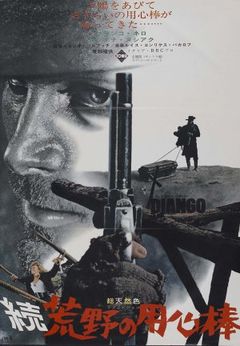
|
| DJANGO (1966) |
Cast:
Music:
Director:
|
Django
View Database page - Review A | Review B
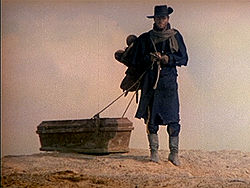
|
According to Alex Cox, Leone was not the only Sergio who wanted to do a remake in spaghetti style of Kurosawa's Yojimbo (1961). Corbucci, generally known as 'the other Sergio', had the same plans. Apparently Enzo Barboni, the future director of the Trinity movies, was the first to see the movie. He ran into Sergio Leone and told him about it. Sergio and his wife saw the film the next day and afterwards Sergio contacted two of his colleagues, Sergio Corbucci and Duccio Tessari. Corbucci, a great lover of Samurai stories and movies, had already seen it and said he was thinking of a remake. Suddenly both Sergios had become rivals (1). Leone came up first with his version, A Fistful of Dollars (Per un pugno di dollari/1964), but Corbucci clearly never gave up his ideas. It seems they finally resulted in his breakthrough and landmark movie Django (1966).
Django, a mysterious loner, who drags a coffin behind him, saves the life of a prostitute named Maria, who was about to be killed by a group of racist vigilantes, dressed like members of the Ku-Klux-Klan, who thought she was 'stained' because she had been touched by Mexicans. It turns out that Django wants to kill the leader of the Klansmen, Major Jackson, who has murdered his wife when Django was 'far away, too far away'. In a bloody shootout, in which he uses the machine gun that was hidden in his coffin, he nearly wipes out Jackson's men. Subsequently he teams up with a Mexican gang, led by his old friend Rodriguez, and with them steals a load of federal gold. When he's afraid that Rodriguez isn't willing to pay him his share, he steals the loot and tries to escape with it, accompanied by the prostitute Maria, but due to an accident, they're overtaken by the Mexicans. Mario is shot (but survives) and Django's hands are crushed by horses' hooves. Major Jackson has made a deal with the Federales and in a bloody ambush the Mexican bandits are massacred. With his last five men, he goes back to town, where he is told that Django is waiting for him on the churchyard.
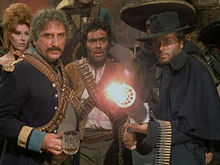
|
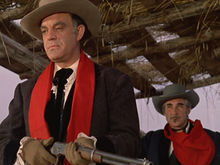
|
In many aspects Django is simply a darker, dirtier and more sadistic reading of the story of 'the two warring factions and the man in the middle'. Both Leone and Corbucci had learned the story from Kurosawa, but Kurosawa himself had based parts of his movie on an original American novel, Red Harvest, by Dashiel Hammett. The main difference, story-wise, between Leone's and Corbucci's adaptation, is the background of the lone gunfighter: in A Fistful of Dollars he was a passer-by, an opportunist who intervenes in a conflict because he sees money in it. In Django he has a score to settle with the leader of one of the warring factions. The second distinction is Corbucci's decision to politicize his movie. By depicting one of the warring factions as a sort of KKK organization of Confederate vigilantes, Corbucci made a clear anti-racist statement (some say even an anti-American statement). Allegedly Corbucci had studied news-reels with recordings of Ku-Klux-Klan gatherings and modeled some movements of his actors after them, notably during the scene in which they parade in the town street towards Django, waiting for them near a tree stump.
And than there is this accident with the rifle, the moment Django and Maria are about to cross the bridge over a pool of quicksand, that will lead them out of Hades, as Phil H has called it in his admirable review. The coffin with the gold falls of the wagon and glides into the pool, and trying to save it, Django nearly drowns with the coffin and must be saved by the Mexicans, the very people that will mutilate him for life. He could have escaped with Maria, the converted harlot who worships her saviour unconditionally, but it's his greed that prevents him from starting a new life. The sequence is a strong anti-capitalist statement, as well as an expression of Corbucci's interpretation of Christ as proto-marxist, unsuccessful revolutionary. Maria lies wounded on the bridge (at his feet) when Django's hands are crushed (Corbucci's version of the crucifiction).
Corbucci got his chance to realize his own vision on the Yojimbo story when he was addressed by a young and ambitious producer Manolo Bolognini, who had worked as production manager for Pasolini on The Gospel according to Matthew, but had lost a lot of money with his previous production (his first one as independent producer), La Donna del Lago (1965). To recuperate his money, people had advised him to make a spaghetti western. He had chosen Corbucci because he had helped out Alfredo Antonini (Albert Band) with Massacre at Grand Canyon (Massacro al Grande Canyon/1964). When he was asked Corbucci was still working on Johnny Oro (1965, released in 1966), and left that production in a hustle, leaving it to others to finish it. But there was a problem. Corbucci desperately wanted to make this film, but he had no story, only a few ideas, and was only given a few days to come up with a script.
To make a lasting impression, Corbucci knew that Django had to be a more 'dirty' personality than No Name, both in behavior and appearance. No Name had been an unshaven, poncho clad and pretty imposing character, but you wouldn't have walked away from him at first sight. With his mud stained black clothes and the coffin he is dragging behind him, Django looks very much like the Devil's dirty brother. To underline his outlandish nature, it was decided that he would not ride a horse. Like this he would be closer to his artistic source, the wandering samurai from the stories and movies. It's often said that Corbucci was inspired by a comic book character dragging a coffin, he had once seen in a newspaper, but I have my doubts about this: many people have tried, but as far as I know nobody has been able to identify this comic book.
With no more than a rough idea about the film's hero, Corbucci went to a friend, Piero Vivarelli, and together they wrote the outlines of the story, working backwards from the final scene, that was conceived with Minnesota Clay (1965) in mind: if a blind gunman was fascinating, why not have a gunman who was no longer able to use his hands properly? The first draft was handed over to Franco Rosetti, who revised it and ... and then things get a little blurry. Both Vivarelli and Rossetti claim to have done the final revision, but Bruno Corbucci (Sergio's brother) sustains he rewrote most scenes nearly completely on the set and also contributed to the fist drafts of the story (he is indeed credited for that), and it's also said that at a certain point (probably during the production too) a revision was done (uncredited) by Fernando di Leo. With Ruggero Deodato as assistant-director and Enzo Barboni as director of photography, Corbucci had some kind of dream team, but still there were problems. Corbucci had promised the part already to Mark Damon, but Bolognini wanted Franco Nero or Fabio Testi. Finally Corbucci accepted Nero (according to Deodato, in a interview with Mario Giusti, it was Sergio's wife Nori who convinced her husband to take Nero). But twenty-four hours of filming, there were new troubles. Instead of the muddy main street - a clear reference to Shane (1953) - Corbucci wanted snow. When this was refused, he left the set and it took Bolognini and Nori Corbucci two days to persuade him to turn back to it. As a result of all this, as well as the undisputed status of cult movie the film has achieved over the years, various people involved in the project have claimed to have directed some scenes: Deodato, Bolognini, Barboni ...
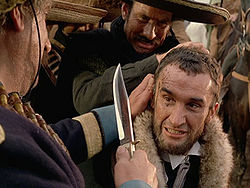
|
In all sincerity, I can hardly imagine that many scenes were directed by any other than Corbucci: nearly the entire movie wears his signature. It's all there, his arresting imagery (the Klansman parading, the bridge out of Hades), the coarse gags (the catfight in the mud), the over the top violence (the cutting of the ear, the use of the Gatlin gun), his strong visual style, instantly recognizable, and his predilection for religious satire, with (apart from the things already mentioned) a priest-spy, working for the KKK, who's forced to eat his own ear because he has heard too much ... On the other hand, the numerous revisions by several writers certainly are perceptible throughout the movie: the script often seems a little disjointed, with some scenes thrown in or not highly finished (the barroom brawl for example) and others too drawn-out (the scene in which Nero prepares the robbery of the gold, climbing over houses with his coffin, while a prostitute is diverting the Mexicans with a striptease). But for a film that was shot within weeks and on a fairly reduced budget, it looks mighty accomplished. It's not Corbucci's best, therefore it is too episodic and the description of the Mexicans too simplistic. But it works on a near subconscious level, forcing the viewer along in a series of increasingly violent set pieces, beginning with the whipping of the harlot and finally resulting in Django balancing his pistol with his crushed hands on a cross, his nemesis Major Jackson shooting holes in it, invoking the Father, the Son and the Holy Ghost (at least in the Italian version), before Django chases the evil spirits of the past in one outrageous, frantic frenzy.
In Spain was filmed in Colmenar Viejo and La Pedriza of Manzanares El Real, both near Madrid. Additional scenes were shot at Tor Caldara, near Anzio, while the final scene was shot in the Canalone di Tolfa, both in the Roman Lazio area. Although the exterior scenes are sublime, the film is more famous for the so-called 'interiors', filmed in the western town of the Elios studios. In an interview in the magazine Segno Cinema Enzo Barboni has explained that during the two weeks of shooting in the Elios studios, they hardly had a ray of sunlight. Clouds as grey and heavy as lead covered the sky nearly permanently, making it extremely difficult for the crew to chose the right light. Many scenes turned out to be under-exposed afterwards, but the type of negative that was used, permitted this, and everybody was enthusiastic about them, and Barboni was asked repeatedly how on earth he had created the effect. Some scenes have become legendary, notably the cutting of the ear, copied by Tarantino in Resevoir Dogs, the shootout at the churchyard, and of course the opening scene, Nero dragging his coffin through the mud. It's not clear who came up with the title, although all involved in the production agree it is a reference to guitar player Django Reinhardt. Corbucci seemed to have liked the name as well as the fact that Reinhardt was a gypsy, a total outsider in society, like the character he had in mind.
Django received a '18' certificate that harmed its chances at the box-office considerably, and although it still was pretty successful at home, it has long time been more popular abroad, especially in Germany. In Great Britain it was banned and not shown before the early nineties, when Alex Cox presented it in his late night Moviedrome. Watched today, the violence has of course lost some of its impact, and the machine gun scene, although well-crafted, looks a bit silly, with Nero shooting from the hips and nearly collapsing under the load, but overall Corbucci's gritty, detailed attention to the violence might still have a few surprises in store for unprepared viewers. With several unrelated films retitled to cash in on its popularity - in Italy those films are called Sotto Django (under-Djangos) - the film created its own myth. In Germany more than fifty films became bastard babies, and more in general both the film and its hero became identified with the vengeance tale. It seems that film makers have more tried to copy the mood of the film and its tormented hero than its visual style, even though there was a tendency to hide fire-arms in rather odd objects such as banjos or bibles (a gag copied by Rodriguez in the El Mariachi trilogy, in which the protagonist hides his weaponry in his guitar case). But in spite of the popularity of Django , Leone's flashback style remained dominant within the subgenre of the revenge western (surprisingly there is no flashback). The film that probably comes closest to the visual style, estranged atmosphere and violent antics, Questi's surreal Django Kill (Se sei vivo spara/1967), is definitely a different film, more a trip than a nightmare. It's remarkable how popular Django still is today. Not only is there a Japanese (sort of) remake, Sukiyaki Django, but he apparently inspired several punk and metal bands like Rancid, Thrones and Rob Zombie, who all recorded songs with strong references to the character and the film.
Notes:
Links:
- Django - Character Page
- Review Phil H
- Alex Cox: http://www.alexcox.com/
- Dashiell Hammet: http://en.wikipedia.org/wiki/Dashiell_Hammett http://en.wikipedia.org/wiki/Red_Harvest
--By Scherpschutter
Page Design by dicfish



